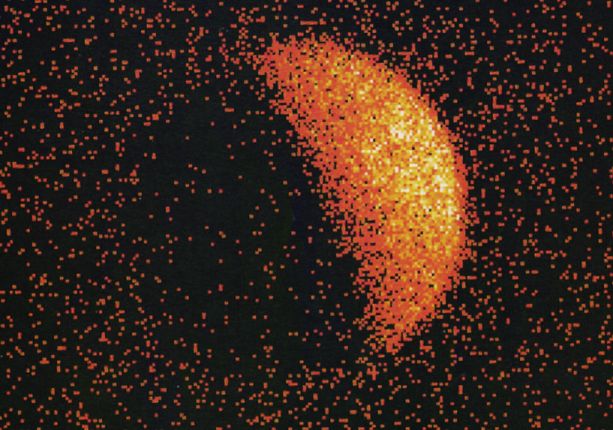Explanation: This x-ray image of the Moon was made by the orbiting ROSAT (Röntgensatellit) Observatory in 1990. In this digital picture, pixel brightness corresponds to x-ray intensity. Consider the image in three parts: the bright hemisphere of the x-ray moon, the darker half of the moon, and the x-ray sky background. The bright lunar hemisphere shines in x-rays because it reflects x-rays emitted by the sun ... just as it shines at night by reflecting visible sunlight. The background sky has an x-ray glow in part due to the myriad of distant, powerful active galaxies, unresolved in the ROSAT picture but recently detected in Chandra Observatory x-ray images. But why isn't the dark half of the moon completely dark? It's true that the dark lunar face is in shadow and so is not reflecting solar x-rays. Still, the few x-ray photons which seem to come from the moon's dark half are currently thought to be caused by energetic particles in the solar wind bombarding the lunar surface.
1999 2000 2001 2002 2003 2004 2005 2006 2007 2008 2009 2010 2011 2012 2013 2014 2015 2016 2017 2018 2019 2020 2021 2022 2023 2024 2025 |
Январь Февраль Март Апрель Май Июнь Июль Август Сентябрь Октябрь Ноябрь Декабрь |
NASA Web Site Statements, Warnings, and Disclaimers
NASA Official: Jay Norris. Specific rights apply.
A service of: LHEA at NASA / GSFC
& Michigan Tech. U.
|
Публикации с ключевыми словами:
Moon - x-ray background - cosmic rays - космические лучи - Луна - рентгеновское излучение - рентгеновский фон
Публикации со словами: Moon - x-ray background - cosmic rays - космические лучи - Луна - рентгеновское излучение - рентгеновский фон | |
См. также:
Все публикации на ту же тему >> | |
